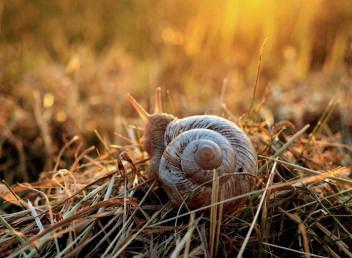
8 minute read
Wildlife
wildlife Too Hot To Handle
Here in France we normally expect a pile in the middle of the lawn. Amazingly, good, hot summer, with a few hours later, just before dawn, a scan temperatures well into the 30°C bracket with a fluorescent lamp showed that the (that is mid-70°F and above in snails had, for the most part, sorted old money). themselves back into the appropriate areas Does this have any effect upon the wildlife that shares the summer with us? It can have a very strange effect upon humans that are unfamiliar with it. It produces a response which involves stripping off almost all protective clothing and spreading the now unshielded skin under of the garden. What took everyone by surprise was that the Cornish snails, a hundred miles from home, all set off in a south-westerly direction, where lay Cornwall. Even at full speed, travelling day and night, it would take at least 6 months to get there! the pitiless sun for a few hours. This, of On a hot afternoon, of course, a snail will course, allows ultra-violet radiation to be seriously dehydrated before it has penetrate that skin and by evening gives crossed your garden path. an effect rather as if a flame-thrower had been passed over the body. This is the reason that it goes quiet on the snail-front in summer in this region. You I worked in Exeter during the Great have spent the spring stepping on earlyHeatwave of 1976. Few people in the UK morning snails or fighting to keep them off had ever experienced sunshine on that your lettuce-bed; now suddenly they have scale. During the holiday period the vanished. They have in fact aestivated. easiest day to go shopping in the city was This is not some form of migration; it is Monday, when all the newly-arrived the summer equivalent of hibernating. If vacationers headed for the beaches. The you look carefully in the cooler, shaded day when it was fun to go shopping was areas of your garden, you will find hordes Tuesday, when one could watch the same of snails dozing peacefully, their shell folk walk slowly along the High Street, openings sealed with a membrane of dried wriggling red-raw shoulders under the mucous, conserving moisture. They often lightest shirt they could bear, and push their way behind things for extra whimpering. Social distancing was protection. strictly observed! Not many animals use this technique, No other creature would behave that way. mainly because the summer is the time of A “cold-blooded” maximum activity for vertebrate will bask in the sun if its body temperature You have spent the spring stepping on early-morning snails or fighting them, and because they have other mechanisms to cope with the needs to be raised, to keep them off your lettuce-bed; situation. One of the but will go about its now suddenly they have vanished most dedicated business when it aestivators is the lunghas reached a good fish, which seems to working temperature. Most mammals are have got all its choices wrong. It lives in covered with fur and enough natural mud-wallows because, having lungs, it, a pigment to protect them, though cats with fish, is better off breathing air. The mud, white ears may need watching if they of course, tends to dry out, and the spend time in hot sun. lungfish copes with this by burying itself in There are a lot of creatures, of course, that are not equipped to avoid or deal with strong sunlight. One such is the Garden Snail Cornu aspersum. The snail is the mud at the last minute, surrounding itself with mucous to conserve moisture, and waiting until the rains come. A rather risky strategy. famously slow-moving (maximum speed Plants also react to the hot weather, but for it is hard to discover, since each their requirements for water are rather authority quotes it in different units, but it more urgent. They cannot go looking for seems to be 50 metres/hr). it, nor can they hide away from the heat. Its slow speed does not mean that the snail has no ambition. Recently an informal test was tried whereby snails from all four sides of an ordinary suburban Midland As all gardeners and farmers know, it is down to us to provide the water for them, and woe betide any plant that gets forgotten. garden were collected. They were painted Some do have coping strategies. The with a different colour of fluorescent paint Tumbleweed plant so familiar to us from depending on where they had been old Western films is able to wither down to collected (north, south, east or west a ball of apparently dry sticks if it loses its section of the garden), mixed with some source of water, and allows itself to be control snails brought from far-distant picked up by the wind and carried vast Cornwall, painted yet a different colour distances. When it chances upon again, and all released by tipping them in a moisture, it will send out roots to anchor
Advertisement
By Mike George
Mike George is our regular contributor on wildlife and the countryside in France. He is a geologist and naturalist, living in the Jurassic area of the Charente


itself and take advantage of the new-found life-giver. While it is bowling along, of course, it is scattering its seeds in quantity. These will lie in the soil until moisture arrives. Incidentally, the plant is not of American origin, but Russian, and was accidentally introduced in 1877 by Ukrainian immigrant farmers among flax seeds. It found the plains of the US ideal to its lifestyle, and also lacking in its natural predators. Any tumbleweed that you see blowing about in a Western dated any earlier than the late 19th century is definitely out-of-place. When “The Sons of the Pioneers” intoned their mournful ditty about “The Tumblin’ Tumbleweed” in the 1940s, it had been a problem for less than 70 years. Some trees have developed the technique of storing water in their tissues during the wet season for use in the dry months. These trees are enormously useful to knowledgeable travellers, who can tap the water for use at need. Finally, there is a frog in Australia that fills its stomach with water when it feels a drought coming on, and buries itself to live off this store. The Aboriginal Australians, who have a very welldeveloped sense of nature, can find these at need and squeeze out the frog to gain the water for their own survival. They do this sparingly, of course, because the result is fatal to the frog.
WARNING - TOXIC
All parts of the Datura stramoniumplant are poisonous and potentially fatal, especially the flowers and seeds, and their effects on the brain are unpleasant to dangerous

Also known as thornapples, jimsonweeds, moonflower, devil's weed and hell's bells
By Mike George


What to Look Out For in August
Although it is still summer, the winter crane migration can begin this early, and continues into October. A doleful, distant creaky honking signals one or more skeins of cranes in flight. They should be heading south westward to their wintering grounds around the western Mediterranean coast. I have to say I find the sight of these flights uplifting in spring, but somewhat depressing in autumn – even more so in late summer! August can be a time of violent thunderstorms. Remember, if a tree you value is damaged or even blown down, get advice from a specialist as to whether it can be saved, but trust your neighbours more. My walnut tree is still recovering from being re-erected after the 2013 tempest, but it is surviving, and giving walnuts. If it hadn’t been for my neighbours helping (it took two tractors) the tree-surgeon would never have got it upright! Daturas start to flower. They often occur where maize has been grown. Remember the white flower is trumpetshaped and looks like a very large convolvulus flower, but the leaves are totally different. The seed-pod is walnut sized, green and spiky. Avoid this plant – it is highly toxic. It is the Loco (madness) Weed of the southern US, and the Apple of Death of India. Butterflies are usually very active. Do leave them plenty of weeds and flowers to feast on to ensure next year’s broods get a good start. Clumps of Ice-Plant can provide good late fuel for them. And don’t forget to leave clumps of nettles for the Tortoiseshell and Red Admiral caterpillars. Last month I confidently stated that you are unlikely to see a Brimstone butterfly at this time of the year. Since that came out, I have seen several, both male and female. All goes to show one should never make predictions. Moths are active, too, so watch for the large hawk-moths. Tiger-moths are also to be seen. Watch for the Jersey Tiger Moth (Fr: Écaille chinée). This day-flying moth has brown-and cream splinter camouflaged forewings and vivid orange or yellow hind-wings. The suddenness with which the moth vanishes as it folds its wings is astounding. Bats hunt the night moths, but the moths have some cunning avoidance schemes. See if you can spot a bat being misled by the radar-jamming skills of a large moth, and missing what looks like an easy catch. A lot of birds will be well through their second brooding, and some may be thinking of a third. Sadly, the weather can change in September leading to a shortage of food and starving chicks. Hedgehogs can suffer from the same problem – a late brood can leave too little time for the young to build up the fat-burden they need to survive hibernation, leading to underweight and starving young hedgehogs in January.









